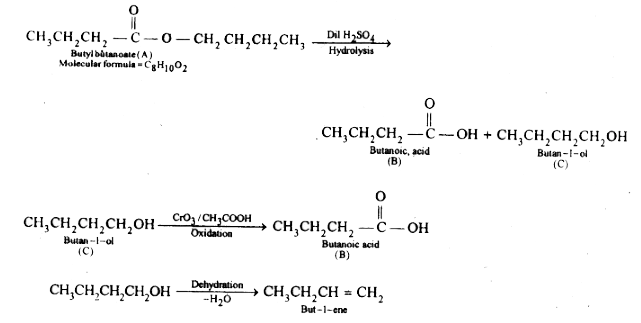An organic compound (A) (molecular formula C8H16O2) was hydrolysed with dilute sulphuric acid to give a carboxylic acid (B) and an alcohol (C ). Oxidation of (C ) with chromic acid produced (B). (C ) on dehydration gives but-1-ene. Write equations for the reactions involved.
Since as ester A with molecular formula C8H16O2 upon hydrolysis gives carboxylic acid B and the alcohoc C and oxidation of C with chromic acid produces the acid B, therefore, both the carboxylic acid B and alcohol C must contain the same number of carbon atoms.
Further, since ester A contains eight carbon atoms, therefore, both the carboxylic acid B and the alcohol C much contain four carbon atoms each .
Since the alcohol C on dehydration gives but-l-ene, therefore, C must be a straight chain alcohol, i.e., buten-l-ol.
If C is butan-l-ol, then the acid B must be butanoic acid and the ester A must be butyl butanoate. The chemical equations are as follows:

Topper's Solved these Questions
Similar Questions
(a) Explain the mechanism of a nucleophilic attack on the carbonyl group of an aldehyde or a ketone.
(b) An organic commpound (A) (molecular formula C8H16O2) was hydrlysed with dilute sulphuric acid to give a carboxylic acid (B) and an alcohol (C). Oxidatin of (C) with chromic acid also produced (B). On dehydratin (C) gives but-1-ene. Write the equations for the reactions involved.View SolutionAn organic compound (A) (molecular formula C8H16O2) was hydrolysed with dilute sulphuric acid to give a carboxylic acid (B) and an alcohol (C ). Oxidation of (C ) with chromic acid produced (B). (C ) on dehydration gives but-1-ene. Write equations for the reactions involved.
View Solution
Knowledge Check
- Question 1 - Select One
An organic compound [A], molecular formula C10H20O2 was hydrolyzed with dilute sulphuric acid to
give a carboxylic acid [B] and an alcohol [C]. Oxidation of [C] with CrO3−H2SO4 produced [B].
Which of the following strucutres are not possible for [A]?A(CH3)3−C−COOCH2C(CH3)3BCH3−CH2−CH| CH3−OCOCH2CH3| CH−CH2CH3CCH3CH2CH2COOCH2CH2CH2CH3DCH3−CH2−CH| CH3−COOCH2−CH3| CH−CH2CH3 - Question 2 - Select One
A compound (X) having molecualr formula C4H8O2 is hydrolysed by water in presence of an acid to give a carboxylic acid (Y) and an alcohol (Z). (Z) on oxidation with chromic acid gives (Y), (X), (Y) and (Z) are
A X Y ZCH3COOCH3CH3COOHCH3OHB X Y ZCH3COOC2H5CH3COOHC2H5OHC X Y ZC2H5COOCH3C2H5COOHC2H5OHD X Y ZCH3COOC2H5C2H5COOHCH3OH - Question 3 - Select One
A compound A with molecular formula C6H10 on oxidation with hot KMnO4 gives hexandioic acid. A is
A2-HexyneB1,5-HexadieneC1,3−HexadienceDCyclohexane
(a) How will you bring about the following conversions :
(i) Ethanol to 3- hydroxybutanal
(ii) Benzaldehyde to Benzophenone
(b) An organic compound A has the molecular formula C8H16O2. It gets hydrolysed with dilute sulphuric acid and gives a carboxylic acid B and an alcohol C. Oxidation of C with chromic acid also produced B . C on dehydration reaction gives but - l - ene . write equations for the reactions involved.View SolutionAn organic compound (A) (molecular formula, C4H8O2) was hydrolysed with dilute H2SO4 to give a carboxylic acid (B) nd an alcohol (C). Oxidation of (C) with chromic acid produced (B). Write possible structures of (A), (B) and (C) and give their IUPAC names. write chemical equations involved in the process.
View SolutionA liquid (X) having a molecular formula C6H12O2 is hydrolysed with water in the presence of an acid to give a carboxylic acid (Y) and an alcohol (Z). Oxidation of (Z) with chrome acid gives (Y) . What are the structures of (X),(Y), and (Z) ?
View SolutionAn organic compound (A) (molecular formula C6H12O2) was hydrolysed with dil . H2SO4 to give carboxylic acid (B) and an alcohol (C). 'C' gives white turbidity immediately when treated with anhydrous ZnCl2 and conc. HCl . The organic compound (A) is
View SolutionAn organic compound 'X' with molecular formula C2H6O, on oxidation with acidified potassium dichromate gives ethanoic acid. What is the compound X? Write equation also.
View Solution

